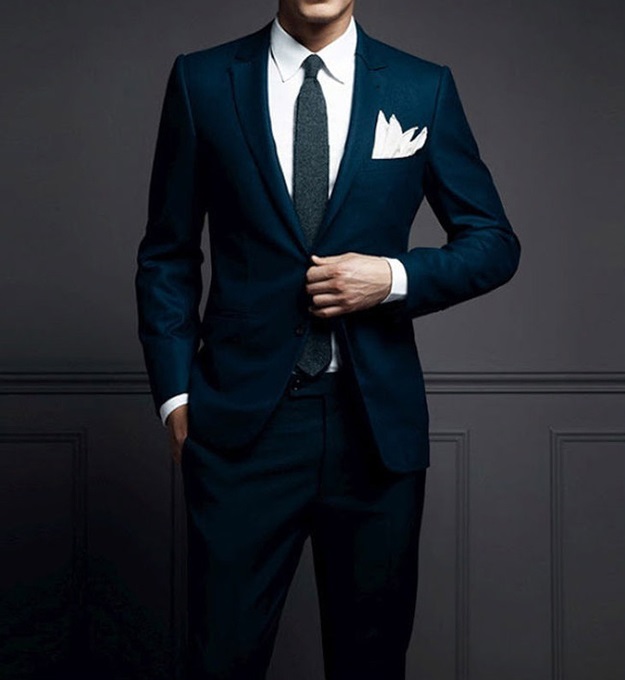A tuxedo is an English invention, the inhabitants of foggy Albion call it dinner-jacket (literally, a dinner jacket), the Germans just call it a jacket, and the Americans call it tuxedo. The first tuxedo was sewn in 1860 for the Prince of Wales by the famous London tailor Henry Poole. The lapel jacket was for domestic use only. It was comfortable to sit in an easy chair and smoke a cigar after a good dinner. It was then strictly forbidden to appear in a tuxedo at official ceremonies.
According to legend, the tuxedo gained secular status in 1880: one day in Monte Carlo, poker players were so carried away by the game that they forgot to change their everyday tuxedo for a traditional evening tailcoat in their excitement.
Traditions and fashion
Most often in the wardrobe of a gentleman you can see a classic tuxedo. The classic tuxedo is a jacket with long lapels trimmed with black silk.

The current fashion is not too conservative: a tuxedo can be single-breasted or double-breasted, with an English collar or a shawl collar, with two, four or six buttons. Now, in addition to black tuxedos, there are dark blue and even purple ones. However, colored tuxedos are not recommended for official receptions.
Tuxedo dress code
The tuxedo is paired with a white shirt and a black bow tie. A black vest or black silk belt is worn over the shirt.
For classic trousers with stripes (this is exactly what tuxedo trousers should be) they pick up black shoes made of thin shiny leather, with laces, low heels, elongated or rounded toes and very thin soles. Socks – black, silk, long, and even better socks.
A boutonniere will add a bright touch to a gentleman’s suit – a living flower in a buttonhole: usually it is a chrysanthemum, rose, freesia or orchid.
A handkerchief peeking out of a breast pocket is appropriate: according to the rules, it should be white, but modern fashion allows scarlet, crimson and other colors.
Wedding ceremonies
A wedding is usually held in more traditional ways than most other social occasions, and the formal part of the wedding is by far the most solemn event. If you are invited to a ceremony that starts after 6 pm, then there is a chance that the guests will be dressed according to the Black Tie rules. If you are invited to take part in a wedding or marriage ceremony, it is recommended that you dress according to the White Tie rules.
Evenings at sea
Many traditionalists lament the loss of formal cruising tradition. For example, Miss Manners says that the toilets on cruise evenings are increasingly reminiscent of the clothes of the “standard tourist” and deeply regrets that passengers who steadfastly adhere to the custom of wearing a tuxedo at dinner are now a rarity.
Miss Manners would still like to see proof of the intention to dress in evening wear, even if it is in the form of suitcases full of evening wear that can be found after a shipwreck.
Although Black Tie is no longer the undisputed prescription for evenings at sea due to the advent of budget cruises, it is nonetheless the most popular option for most gentlemen to wear a tuxedo. Indeed, some cruise lines are so proud of their regimented formal dress code after 6 pm that it feels a little overkill to require guests to wear a tuxedo not only at dinner, but throughout the evening. But rules are rules.
The number of official nights on the liner may vary depending on the route, and sometimes the ship itself. The first and last evenings of the cruise are always informal, as most passengers’ wardrobes are still or already packed. Evenings at the port are also considered unofficial as they do not provide enough time for passengers to change their clothes before dinner.

To increase the number of Black Tie evenings, it is recommended to look for routes during which the ship will be at sea for several days – such as transatlantic crossings aboard Cunard ships. And, of course, there is no more reasonable evening to wear a white tuxedo than an evening on board a cruise ship!
Diplomatic functions
White Tie is eminently suitable for ceremonial diplomatic functions such as state dinners. However, this tradition is observed today only by the royal houses of Europe. American President Bush Jr. put an end to White Tie regulations in the White House Diplomatic Corps after he took office in 2001, making Black Tie formal business attire.
This remark is often countered by U.S. presidents with the last two White Tie parties still held in the country: the Gridiron Club Dinner, hosted by Washington’s oldest journalism organization, and the Alfred E. Smith Memorial Foundation Dinner in New York, which celebrates a Catholic charity fundraiser.
Institutional dress codes
Official events of such prestigious universities as Cambridge and Oxford, as well as fraternal organizations of the Masonic lodges, will also have a full evening set as their regulations. These historical bands may have their own versions of traditional formal wear codes, elevating them to a form rather than evening wear per se.
